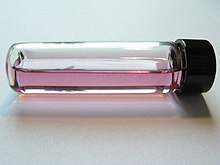



The solubility of fullerenes is generally low. Carbon disulfide dissolves 8g/L of C60, and the best solvent (1-chloronaphthalene) dissolves 53 g/L. up Still, fullerenes are the only known allotrope of carbon that can be dissolved in common solvents at room temperature. Besides those two, good solvents for fullerenes include 1,2-dichlorobenzene, toluene, p-xylene, and 1,2,3-tribromopropane. Fullerenes are highly insoluble in water, and practically insoluble in methanol.
Solutions of pure C60 (buckminsterfullerene) have a deep purple color. Solutions of C70 are reddish brown. Larger fullerenes C
76toC
84 have a variety of colors. C
76 has two optical forms, while other larger fullerenes have several structural isomers.
Some fullerene structures are not soluble because they have a small band gap between the ground and excited states. These include the small fullerenes C
28,[1] C
36 and C
50. The C
72 structure is also in this class, but the endohedral version with a trapped lanthanide-group atom is soluble due to the interaction of the metal atom and the electronic states of the fullerene. Researchers had originally been puzzled by C
72 being absent in fullerene plasma-generated soot extract, but found in endohedral samples. Small band gap fullerenes are highly reactive and bind to other fullerenes or to soot particles.
Solubility of C
60 in some solvents shows unusual behaviour due to existence of solvate phases (analogues of crystallohydrates). For example, solubility of C
60inbenzene solution shows maximum at about 313 K. Crystallization from benzene solution at temperatures below maximum results in formation of triclinic solid solvate with four benzene molecules C
60·4C
6H6 which is rather unstable in air. Out of solution, this structure decomposes into usual face-centered cubic (fcc) C
60 in few minutes' time. At temperatures above solubility maximum the solvate is not stable even when immersed in saturated solution and melts with formation of fcc C
60. Crystallization at temperatures above the solubility maximum results in formation of pure fcc C
60. Millimeter-sized crystals of C
60 and C
70 can be grown from solution both for solvates and for pure fullerenes.[2][3]
The following are some solubility values for C
60 and C
70 from the literature, in grams per liter.[4][5][6][7][8]
| Solvent | C 60 |
C 70 |
|---|---|---|
| 1-chloronaphthalene | 51 | ND |
| 1-methylnaphthalene | 33 | ND |
| 1,2-dichlorobenzene | 24 | 36.2 |
| 1,2,4-trimethylbenzene | 18 | ND |
| tetrahydronaphthalene | 16 | ND |
| carbon disulfide | 8 | 9.875 |
| 1,2,3-tribromopropane | 8 | ND |
| chlorobenzene | 7 | ND |
| p-xylene | 5 | 3.985 |
| bromoform | 5 | ND |
| cumene | 4 | ND |
| toluene | 3 | 1.406 |
| benzene | 1.5 | 1.3 |
| carbon tetrachloride | 0.447 | 0.121 |
| chloroform | 0.25 | ND |
| n-hexane | 0.046 | 0.013 |
| cyclohexane | 0.035 | 0.08 |
| tetrahydrofuran | 0.006 | ND |
| acetonitrile | 0.004 | ND |
| methanol | 4.0×10−5 | ND |
| water | 1.3×10−11 | ND |
| pentane | 0.004 | 0.002 |
| heptane | ND | 0.047 |
| octane | 0.025 | 0.042 |
| isooctane | 0.026 | ND |
| decane | 0.070 | 0.053 |
| dodecane | 0.091 | 0.098 |
| tetradecane | 0.126 | ND |
| acetone | ND | 0.0019 |
| isopropanol | ND | 0.0021 |
| dioxane | 0.0041 | ND |
| mesitylene | 0.997 | 1.472 |
| dichloromethane | 0.254 | 0.080 |
| ND = not determined | ||